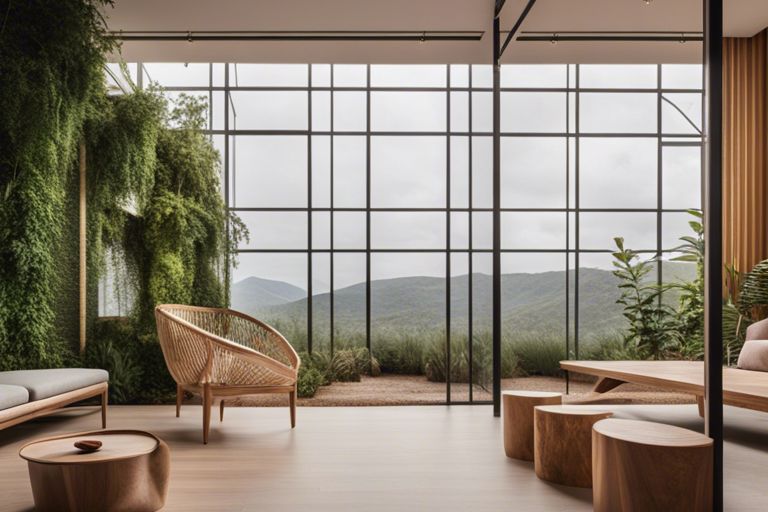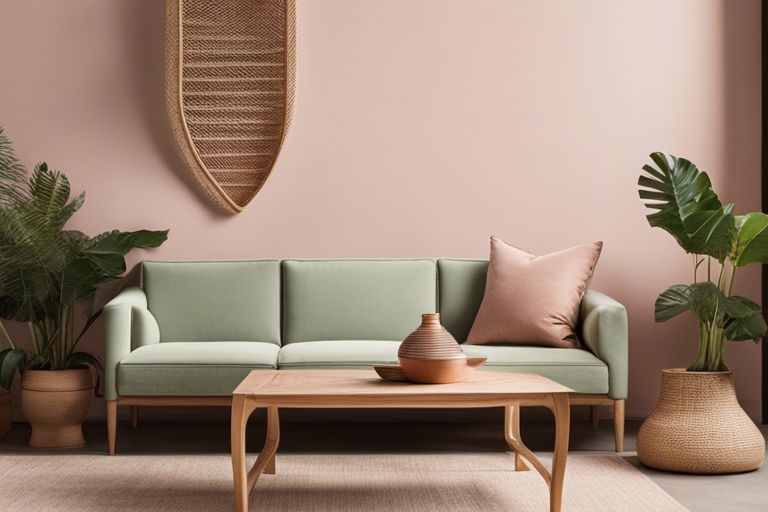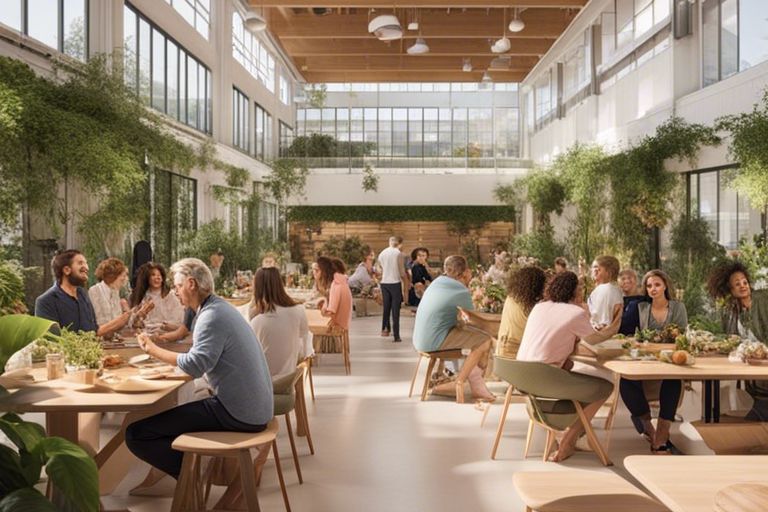With Biophilic Design, you can bring the beauty of nature into your space through intricate details and materials. Embrace the organic and innovative approach inspired by nature, just like the renowned architect Frank Lloyd Wright. Discover how incorporating biophilic design elements can transform your environment into a harmonious and inspiring sanctuary that connects you to the natural world.

Key Takeaways:
- Embrace natural elements: Biophilic design focuses on incorporating natural elements into spaces, such as wood, stone, water, and plants, to create a connection to the outdoors.
- Use textures and patterns inspired by nature: Incorporating textures like leaves, branches, or animal prints, as well as patterns like fractals found in nature, can bring a sense of tranquility and balance to a space.
- Prioritize sustainability: When implementing biophilic design, prioritize sustainable materials and methods to minimize the environmental impact of the project while enhancing the well-being of occupants.
The Principles of Biophilic Design
Before delving into the intricate details of biophilic design, it’s important to understand the fundamental principles that guide this nature-inspired approach to architecture and interior design. Biophilic design aims to create spaces that foster a strong connection with nature, promoting a sense of well-being, productivity, and overall happiness.
Connecting with Nature
Nature plays a crucial role in biophilic design, as it seeks to bring elements of the natural world into built environments. By incorporating natural materials, textures, and patterns, you can create a space that resonates with the tranquility and beauty of the outdoors. Integrating elements such as wood, stone, water features, and living plants can help to blur the lines between indoor and outdoor spaces, allowing you to feel more grounded and connected to the natural world.
Natural Light and Ventilation
The use of natural light and ventilation is another key aspect of biophilic design. Maximizing the amount of natural light that enters a space can not only reduce the need for artificial lighting, but it can also improve mood, focus, and overall well-being. Similarly, ensuring adequate ventilation helps to create a healthier indoor environment by reducing air pollutants and promoting a sense of freshness.
This focus on natural light and ventilation can greatly impact your experience within a space, creating a more comfortable and inviting atmosphere that mimics the benefits of being outdoors.
Materials Inspired by Nature
It’s vital to choose materials that not only look beautiful but also mimic the natural world around us. Incorporating elements like wood, stone, and plants into your design can bring a sense of tranquility and connection to nature into your space.
Wood and Its Variations
Materials like oak, pine, or walnut can add warmth and texture to your interiors. Consider using reclaimed wood for a more sustainable option or experiment with different finishes to create a unique look. Incorporating wood elements in your furniture, flooring, or even wall paneling can create a cozy and inviting atmosphere in your space.
Stone and Its Textures
Inspired by the earth’s natural beauty, stone materials like marble, granite, or slate can bring a sense of elegance and timelessness to your design. Embrace the textures of natural stone, whether rough or polished, to add visual interest and depth to your space. Consider using stone accents in your countertops, backsplashes, or even as statement pieces like a fireplace surround.
Plants and Green Walls
To create a truly immersive biophilic design, incorporating plants and green walls can bring life and color into your space. Adding potted plants or installing a green wall can improve air quality, reduce stress, and enhance your overall well-being. Choose a variety of plants with different shapes and sizes to create a dynamic and lush environment in your home or office.
Walls covered in greenery can act as natural air purifiers and insulation, helping regulate the temperature and humidity in your space. Consider installing a green wall in your living room, office, or even bathroom to create a serene and refreshing oasis within your home.
Organic Forms and Shapes
Many elements of biophilic design draw inspiration from the natural world, particularly when it comes to organic forms and shapes. Incorporating curves, spirals, and irregular shapes in architecture and interior design can mimic the randomness and beauty found in nature.
Curved Lines and Free-Flowing Spaces
Shapes such as arches, circles, and undulating forms can create a sense of movement and fluidity in a space, promoting a feeling of relaxation and harmony. Curved lines can help soften the harsh angles of traditional design, inviting a more natural and calming environment. By incorporating free-flowing spaces, you can encourage a sense of exploration and discovery within your living or working environment.
Geometric Patterns and Natural Motifs
FreeFlowing incorporating geometric patterns inspired by nature, such as the Fibonacci sequence or fractal patterns, can add an element of visual interest and complexity to a design. These patterns can be found in leaves, seashells, and flowers, and integrating them into your space can evoke a sense of wonder and awe at the intricate beauty of the natural world.
To truly embrace biophilic design in your space, consider incorporating a mix of organic forms and geometric patterns to create a harmonious balance between the free-flowing shapes of nature and the structured symmetry of man-made design.
Nature-Inspired Colors and Textures
Unlike other design trends, The Case for Bringing Nature Inside, biophilic design draws inspiration directly from nature’s color palette and textures. By incorporating these elements into your space, you can create a harmonious environment that promotes well-being and connection to the natural world.
Earthy Tones and Natural Hues
Textures play a crucial role in biophilic design, with rough and smooth surfaces mimicking the textures found in nature. Earthy tones and natural hues like greens, browns, and blues can evoke a sense of tranquility and relaxation, bringing the outdoors inside your home or workspace. These colors are known to reduce stress and improve overall mood, creating a soothing atmosphere for you to thrive in.
Rough and Smooth Textures
Colors also play a significant role in biophilic design, with different hues evoking various emotions and feelings. Incorporating rough textures like natural stone or wood can add depth and visual interest to your space, while smooth textures like polished metal or glass can reflect light and create a sense of openness and airiness.
Reflective and Iridescent Surfaces
Tones are vital in creating a dynamic and engaging space. Reflective and iridescent surfaces like mother-of-pearl or metallic finishes can add a touch of luxury and sophistication to your design. These surfaces can mimic the way light plays off water or leaves in nature, creating a mesmerizing effect that captures your attention and enhances the overall ambiance of the space.
Earthy tones and natural hues, rough and smooth textures, and reflective and iridescent surfaces all come together to create a multi-sensory experience that connects you with the beauty of the natural world. By incorporating these elements into your design, you can transform any space into a sanctuary that rejuvenates your spirit and inspires creativity.
Biophilic Design in Practice
Residential Spaces
To create a biophilic design in your residential space, incorporate natural elements like plants, water features, and natural materials such as wood and stone. Your living area can benefit from large windows that provide views of greenery or natural landscapes, bringing the outdoors inside. An indoor garden or a vertical plant wall can add a touch of nature to your space, enhancing the visual appeal and improving air quality.
Commercial and Public Buildings
For commercial and public buildings, integrating biophilic design elements can enhance the overall atmosphere and user experience. Consider incorporating elements such as green roofs, atriums with natural light, or biophilic art installations to create a connection to nature. These elements can improve employee well-being, productivity, and customer satisfaction, making the space more inviting and comfortable.
This approach can also benefit retail environments, restaurants, and healthcare facilities by creating a calming and stress-reducing atmosphere. By incorporating natural elements, colors, and textures, these spaces can evoke a sense of tranquility and relaxation, improving the overall experience for visitors and occupants.
Urban Planning and Landscape Design
Public spaces play a crucial role in creating sustainable and livable cities. Integrating biophilic design principles in urban planning can help improve air quality, reduce urban heat island effects, and promote biodiversity. Parks, green corridors, and rooftop gardens can provide spaces for recreation and relaxation, enhancing the quality of life for urban residents.
Understanding the importance of biophilic design in urban landscapes can lead to the development of more sustainable cities that prioritize human well-being and environmental conservation. By incorporating natural elements and green spaces, urban planners can create healthier and more vibrant communities for everyone to enjoy.
The Benefits of Biophilic Design
Physical and Mental Well-being
Mental well-being is a crucial aspect of our overall health, and biophilic design can have a significant impact on your state of mind. By incorporating elements of nature into your living or working spaces, such as natural light, plants, and natural materials, you can reduce stress, improve your mood, and increase feelings of relaxation and well-being. Studies have shown that being surrounded by nature, even in the built environment, can help lower blood pressure, reduce anxiety levels, and promote mental clarity.
Productivity and Focus
On the other hand, biophilic design can also enhance your productivity and focus. By bringing the outdoors inside, you can create a stimulating environment that energizes your mind and encourages creativity. Natural elements like wood textures, water features, and greenery can help reduce distractions, increase cognitive function, and boost your overall performance. When you feel connected to nature in your workspace, you are more likely to stay engaged, motivated, and focused on your tasks.
Physical workspaces designed with biophilic elements have been shown to improve productivity. By incorporating natural light, ventilation, and views of nature, employees can experience reduced stress levels and increased job satisfaction. Additionally, incorporating biophilic elements can lead to fewer sick days and higher morale among workers, ultimately benefiting the overall success of the organization.
Sustainability and Environmental Impact
Environmental sustainability is a growing concern in the design and architecture industries, and biophilic design offers a solution to reduce our environmental footprint. By using natural materials, incorporating green spaces, and designing with energy-efficient principles in mind, you can create spaces that are not only beautiful but also environmentally friendly. Biophilic design promotes a deeper connection to nature and encourages a more sustainable way of living.
Productivity can be significantly boosted in biophilic spaces due to the improved air quality and overall comfort they provide. Plants can help purify the air, reduce toxins, and regulate humidity levels, creating a healthier indoor environment. By choosing sustainable materials and incorporating biophilic design principles, you can contribute to a healthier planet while also reaping the benefits of a more productive and enjoyable space.
Summing up
Presently, you have learned about the intricacies of biophilic design and the use of details and materials inspired by nature in architecture. By incorporating elements such as natural light, greenery, textures, and colors found in the environment, you can create spaces that not only look beautiful but also foster a deep connection to nature. This design approach not only benefits the aesthetics of a space but also enhances your well-being by bringing the calming and rejuvenating effects of the outdoors indoors.
FAQ
Q: What is biophilic design?
A: Biophilic design is an innovative approach that incorporates nature and natural elements into the design of spaces to create a harmonious and sustainable environment. It aims to connect people with nature to improve well-being, productivity, and overall quality of life.
Q: How does biophilic design mimic nature’s beauty?
A: Biophilic design mimics nature’s beauty by incorporating elements such as natural light, greenery, water features, and organic shapes and patterns into architectural and interior design. These elements help create a sense of tranquility, connection to the natural world, and overall aesthetic appeal.
Q: What are some materials commonly used in biophilic design?
A: Common materials used in biophilic design include wood, stone, bamboo, cork, and other natural materials. These materials not only enhance the visual appeal of a space but also contribute to a healthier indoor environment by improving air quality and reducing stress levels.


